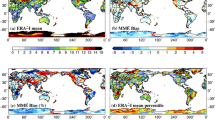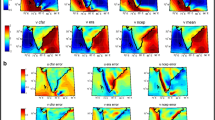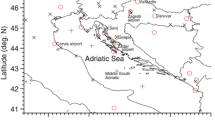Abstract
We present a detailed evaluation of wind energy density (WED) over Portugal, based on the EURO-CORDEX database of high-resolution regional climate model (RCM) simulations. Most RCMs showed reasonable accuracy in reproducing the observed near-surface wind speed. The climatological patterns of WED displayed large sub-regional heterogeneity, with higher values over coastal regions and steep orography. Subsequently, we investigated the future changes of WED throughout the twenty-first century, considering mid- and end-century periods, and two emission scenarios (RCP4.5 and RCP8.5). On the yearly average, the multi-model ensemble WED changes were below 10% (15%) under RCP4.5 (RCP8.5). However, the projected WED anomalies displayed strong seasonality, dominated by low positive values in summer (< 10% for both scenarios), negative values in winter and spring (up to − 10% (− 20%) under RCP4.5 (RCP8.5)), and stronger negative anomalies in autumn (up to − 25% (− 35%) under RCP4.5 (RCP8.5)). These projected WED anomalies displayed large sub-regional variability. The largest reductions (and lowest increases) are linked to the northern and central-eastern elevated terrain, and the southwestern coast. In contrast, the largest increases (and lowest reductions) are linked to the central-western orographic features of moderate elevation. The projections also showed changes in inter-annual variability of WED, with small increases for annual averages, but with distinct behavior when considering year-to-year variability over a specific season: small increases in winter, larger increases in summer, slight decrease in autumn, and no relevant change in spring. The changes in inter-annual variability also displayed strong dependence on the underlying terrain. Finally, we found significant model spread in the magnitude of projected WED anomalies and inter-annual variability, affecting even the signal of the changes.










Similar content being viewed by others
References
Balog I, Ruti PM, Tobin I et al (2015) A numerical approach for planning offshore wind farms from regional to local scales over the Mediterranean. Renew Energy 85:395–405
Cardoso RM, Soares PMM, Miranda PMA et al (2013) WRF high resolution simulation of Iberian mean and extreme precipitation climate. Int J Climatol 33:2591–2608. https://doi.org/10.1002/joc.3616
Cardoso RM, Soares PMM, Lima DCA, Semedo A (2016) The impact of climate change on the Iberian low-level wind jet: EURO-CORDEX regional climate simulation. Tellus A 68:29005. https://doi.org/10.3402/tellusa.v68.29005
Carvalho D, Rocha A, Gómez-Gesteira M, Silva Santos C (2017) Potential impacts of climate change on European wind energy resource under the CMIP5 future climate projections. Renew Energy 101:29–40. https://doi.org/10.1016/j.renene.2016.08.036
Chang EKM, Guo Y, Xia X (2012) CMIP5 multimodel ensemble projection of storm track change under global warming. J Geophys Res 117:D23118. https://doi.org/10.1029/2012JD018578
Cheng WY, Steenburgh WJ (2005) Evaluation of surface sensible weather forecast by the WRF and the Eta Models over the western United States. Weather Forecast 20:812–821.5
Christensen OB, Drews M, Christensen JH, et al. (2006) The HIRHAM regional climate model version 5. Danish Meteorological Institute Technical Report 06-17 2006
Doblas-Reyes FJ, Hagedorn R, Palmer TN (2005) The rationale behind the success of multi-model ensembles in seasonal forecasting. part II: Calibration and combination. Tellus A 57:234–252
Ferro C, Hannachi A, Stephenson D (2005) Simple nonparametric techniques for exploring changing probability distributions of weather. J Clim 18:4344–4354
Giorgi F, Jones C, Asrar GR (2009) Addressing climate information needs at the regional level: the CORDEX framework. Bull World Meteorol Organ 58:175–183
Gómez G, Cabos WD, Liguori G et al (2016) Characterization of the wind speed variability and future change in the Iberian Peninsula and the Balearic Islands. Wind Energ 19:1223–1237. https://doi.org/10.1002/we.1893
Hazeleger W, Severijns C, Semmler T et al (2010) EC-Earth: a seamless earth-system prediction approach in action. Bull Amer Meteor Soc 91:1357–1363. https://doi.org/10.1175/2010BAMS2877.1
Hoinka KP, Castro MDE (2003) The Iberian Peninsula thermal low. Q J R Meteorol Soc 129 (590):1491–1511
Hueging H, Haas R, Born K et al (2013) Regional changes in wind energy potential over europe using regional climate model ensemble projections. J Appl Meteor Climatol 52:903–917. https://doi.org/10.1175/JAMC-D-12-086.1
Jacob D, van den Hurk BJ, Andrae U et al (2001) A comprehensive model inter-comparison study investigating the water budget during the BALTEX-PIDCAP period. Meteorol Atmos Phys 77(1–4):19–43. https://doi.org/10.1007/s007030170015
Jacob D, Petersen J, Effert B et al (2014) EURO-CORDEX: New high-resolution climate change projections for European impact research. Reg Environ Chang 14:563–578
Jiménez PA, Dudhia J (2012) Improving the representation of resolved and unresolved topographic effects on surface wind in the WRF model. J Appl Meteorol Climatol 51(2):300–316
Jiménez P, Dudhia J (2013) On the ability of the WRF model to reproduce the surface wind direction over complex Terrain. J Appl Meteorol Climatol 52:1610–1617. https://doi.org/10.1175/JAMC-D-12-0266.1
Katragkou E, Garcia-Diez M, Vautard R et al (2015) Regional climate hindcast simulations within EURO-CORDEX: evaluation of a WRF multi-physics ensemble. Geosci Model Dev 8:603–618. https://doi.org/10.5194/gmd-8-603-2015
Kotlarski S, Keuler K, Christensen OB et al (2014) Regional climate modeling on European scales: a joint standard evaluation of the EURO-CORDEX RCM ensemble. Geosci Model Dev 7:1297–1333. https://doi.org/10.5194/gmd-7-1297-2014
Kryza M, Wałaszek K, Ojrzyńska H et al (2016) High-resolution dynamical downscaling of ERA-interim using the WRF regional climate model for the area of poland. Part 1: model configuration and statistical evaluation for the 1981–2010 Period. Pure Appl Geophys. https://doi.org/10.1007/s00024-016-1272-5
Lacal-Arántegui R, Serrano-González J (2014) JRC wind status report. Joint Research Centre for the European Comission. ISBN 978-92-79-48380-6
Mass C, Ovens D (2010) WRF model physics: problems, solutions and a new paradigm for progress. Preprints, 2010 WRF Users’ Workshop, Boulder, CO, NCAR. [Available online at http://www.mmm.ucar.edu/wrf/users/workshops/WS2010/presentations/session%204/4-1_WRFworkshop2010Final.pdf.]
Mass C, Ovens D (2011) Fixing WRF’s high speed wind bias: a new subgrid scale drag parameterization and the role of detailed verification. Preprints, 24th Conf. on Weather and Forecasting/20th Conf. on Numerical Weather Prediction, Seattle, WA, Amer. Meteor. Soc., 9B.6. [Available online at http://ams.confex.com/ams/91Annual/webprogram/Paper180011.html.]
Meinhausen M, Smith SJ, Calvin K et al (2011) The RCP greenhouse gas concentrations and their extensions from 1765 to 2300. Clim Chang 190:213–241. https://doi.org/10.1007/s10584-011-0156z
Monforti F, Gaetani M, Vignati E (2016) How synchronous is wind energy production among European countries? Renew Sust Energ Rev 59:1622–1638. https://doi.org/10.1016/j.rser.2015.12.318
Moss RH, Edmonds JA, Hibbard KA et al (2010) The next generation of scenarios for climate change research and assessment. Nature 63:747–756
Perkins S, Pitman A, Holbrook N, McAneney J (2007) Evaluation of the AR4 climate models’ simulated daily maximum temperature, minimum temperature, and precipitation over Australia using probability density functions. J Clim 20:4356–4376. https://doi.org/10.1175/JCLI4253.1
Peterson EW, Hennessey JP Jr (1978) On the use of power laws for estimates of wind power potential. J Appl Meteorol 17:390–394
Pineda I, Tardieu P (2017) Wind in power – 2016 European Statistics. Report; European Wind Energy Association
Prein AF, Gobiet A, Truhetz H et al (2016) Precipitation in the EURO-CORDEX 0.11° and 0.44° simulations: high resolution, high benefits? Clim Dyn:1–30. https://doi.org/10.1007/s00382-015-2589-y
Pryor SC, Barthelmie RJ (2011) Assessing climate change impacts on the near-term stability of the wind energy resource over the United States. Proc Natl Acad Sci U S A 108(20):8167–8171. https://doi.org/10.1073/pnas.1019388108
Pryor SC, Nikulin G, Jones C (2012) Influence of spatial resolution on regional climate model derived wind climates. J Geophys Res Atmos 117(D3). https://doi.org/10.1029/2011JD016822
Reyers M, Moemken J, Pinto JG (2016) Future changes of wind energy potentials over Europe in a large CMIP5 multi-model ensemble. Int J Climatol 36:783–796. https://doi.org/10.1002/joc.4382
Riahi K, Rao S, Krey V, at al. (2011) RCP 8.5—a scenario of comparatively high greenhouse gas emissions. Clim Chang 109:33–57. https://doi.org/10.1007/s10584-011-0149-y
Rios-Entenza A, Soares PMM, Trigo RM et al (2014) Moisture recycling in the Iberian Peninsula from a regional climate simulation: spatiotemporal analysis and impact on the precipitation regime. J Geophys Res Atmos 119:5895–5912. https://doi.org/10.1002/2013JD021274
Rockel B, Will A, Hense A (2008) The regional climate model COSMO-CLM (CCLM). Meteorol Z 17:347–348. https://doi.org/10.1127/0941-2948/2008/0309
Samuelsson P, Jones C, Willén U et al (2011) The Rossby Centre Regional Climate Model RCA3: model description and performance. Tellus A 63(1):4–23
Santos JA, Rochinha C, Liberato MLR et al (2015) Projected changes in wind energy potentials over Iberia. Renew Energy 75:68–80. https://doi.org/10.1016/j.renene.2014.09.026
Skamarock WC, Klemp JB, Dudhia J, et al (2008) A description of the advanced research WRF version 3. NCAR tech. note TN-475_STR 113 pp
Soares PMM, Cardoso RM (2018) A simple method to assess the distribution added value of high-resolution climate simulations: application to the EURO-CORDEX daily precipitation. Int J Climatol 38:1484–1498. https://doi.org/10.1002/joc.526
Soares PMM, Cardoso RM, Miranda PMA et al (2012) WRF high resolution dynamical downscaling of ERA-Interim for Portugal. Clim Dyn 39:2497–2522. https://doi.org/10.1007/s00382-012-1315-2
Soares PMM, Cardoso RM, Semedo A et al (2014) Climatology of Iberia coastal low-level wind jet: WRF high resolution results. Tellus A 66:22377
Soares PMM, Cardoso RM, Ferreira JJ, Miranda PMA (2015) Climate change impact on Portuguese precipitation: ENSEMBLES regional climate model results. Clim Dyn 45:1771–1787. https://doi.org/10.1007/s00382-014-2432-x
Soares PMM, Lima DCA, Cardoso RM, Semedo A (2016) High resolution projections for the Western Iberian coastal low level jet in a changing climate. Clim Dyn 49:1547. https://doi.org/10.1007/s00382-016-3397-8
Soares PMM, Cardoso RM, Lima DCA, Miranda PMA (2017a) Future precipitation in Portugal: high resolution regional climate simulation projections. Clim Dyn 49:2503–2530. https://doi.org/10.1007/s00382-016-3455-2
Soares PMM, Lima DCA, Cardoso RM et al (2017b) Western Iberian offshore wind resources: more or less in a global warming climate? Appl Energy 203:72–90. https://doi.org/10.1016/j.apenergy.2017.06.004
Tobin I, Vautard R, Balog I et al (2015) Assessing climate change impacts on European wind energy from ENSEMBLES high-resolution climate projections. Clim Chang 128:99–112
Tobin I, Jerez S, Vautard R et al (2016) Climate change impacts on the power generation potential of a European mid-century wind farms scenario. Environ Res Lett 11:034013
van Meijgaard E, van Ulft L, van de Berg W, et al (2008) The KNMI regional atmospheric climate model RACMO, version 2.1. Tech. Rep 302 R 2008 Neth Meteorol Inst De Bilt, Netherlands
van Vuuren DP, Edmonds J, Kainuma M et al (2011) The representative concentration pathways: an overview. Clim Chang 109:5. https://doi.org/10.1007/s10584-011-0148-z
Vautard R, Gobiet A, Jacob D et al (2013) The simulation of European heat waves from an ensemble of regional climate models within the EURO-CORDEX project. Clim Dyn 41:2555–2575
Weigel A, Knutti R, Liniger M, Appenzeller C (2010) Risks of model weighting in multimodel climate projections. J Clim 23:4175–4191. https://doi.org/10.1175/2010JCLI3594.1
Wyszogrodzki AA, Liu Y, Jacobs N et al (2013) Analysis of the surface temperature and wind forecast errors of the NCAR-AirDat operational CONUS 4-km WRF forecasting system. Meteorol Atmos Phys 122:125. https://doi.org/10.1007/s00703-013-0281-5
Acknowledgments
The authors wish to acknowledge the projects SOLAR (PTDC/GEOMET/7078/2014) and FCT UID/GEO/50019/2013 - Instituto Dom Luiz, financed by Fundação para a Ciência e a Tecnologia. We acknowledge the World Climate Research Programme’s Working Group on Regional Climate, and the Working Group on Coupled Modelling, former coordinating body of CORDEX and responsible panel for CMIP5. We also thank the climate modeling groups (listed in Table 1 of this paper) for producing and making available their model output. We also acknowledge the Earth System Grid Federation infrastructure an international effort led by the U.S. Department of Energy’s Program for Climate Model Diagnosis and Intercomparison, the European Network for Earth System Modelling and other partners in the Global Organization for Earth System Science Portals (GO-ESSP). Finally, the authors thank IPMA, I.P. for the observational data provided for this work.
Author information
Authors and Affiliations
Corresponding author
Rights and permissions
About this article
Cite this article
Nogueira, M., Soares, P.M.M., Tomé, R. et al. High-resolution multi-model projections of onshore wind resources over Portugal under a changing climate. Theor Appl Climatol 136, 347–362 (2019). https://doi.org/10.1007/s00704-018-2495-4
Received:
Accepted:
Published:
Issue Date:
DOI: https://doi.org/10.1007/s00704-018-2495-4




